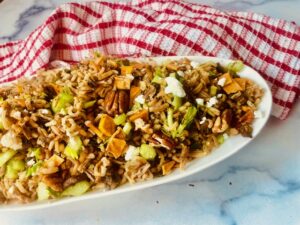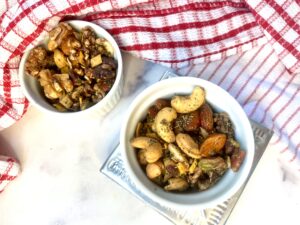
If you have chronic Acid Reflux (or chances are – you know someone who has), you may be aware that coffee, tea, citrus, spicy foods, alcohol and tomatoes are generally off limits.
But did you know that even something as benign as sparkling water can aggravate symptoms of Acid Reflux?
Below are five common staples you may want to watch out for:
1. Bananas
Banana’s may be part of the BRAT diet (bananas, rice, applesauce, toast) that is said to ease tummy trouble.
But depending on its ripeness or level of raw (green), banana’s may be a trigger for some. For one thing ripe bananas are a high-FODMAP food, which can cause bloating for some. Bloat can put pressure on the LES, allowing stomach acids to reflux up the esophagus.
I share more insights about bananas and heartburn in this article for Parade.
2. Sparkling Water
Remember how your mom (or grandma) would have you drink soda to ease your upset stomach. Back in my day it was Coca Cola. Apparently the carbonation was the key. Nowadays there are a wide variety of flavored sparkling waters that don’t contain excess sugars or potentially harmful additives.
But even plain sparkling water, as benign as it may be, is not a great idea for those with reflux. The bubbles put pressure on the lower esophageal sphincter (LES) which can lead to an up flow of acid. Any carbonated beverage can trigger heartburn or any manifestation of reflux. So say no to Kombucha (which BTW is a tea), too!
Tip: Have a glass of water! Still waters are so essential to our overall health and hydration – your body’s preferred beverage. You should be aiming for at least 8 glasses per day. If you prefer a flavored option, try infusing sliced cucumber or watermelon. Unsweetened coconut water, which is high in electrolytes, is another option you can use for an occasional refresher.
3. Raspberries
Raspberries among the variety of berries we enjoy, are a great source of fiber and full of antioxidant nutrients. But these bright sweet berries also have a pH of 3.2 – 3.6, rendering them a more acidic food. Berries in general are more acidic. With a pH of 2.3 to 2.5, cranberries also fall on the low end of the acid chart. A pH above 7 is considered to be Alkaline; While foods that fall below the PH of 7 are more acidic. Thus being highly acidic, these are often trigger foods for those with Acid Reflux.
Tip: Enjoy your favorite berries in a smoothie with almond milk. The almond milk helps neutralize the acid. Try Dr. Aviv’s acid-watcher Almond Berry Smoothie.
4. Milk and Cream (Stay with me here…)
Milk or cream may soothe the burn from acid reflux. My mom said as a child her mom with give her milk or cream to ease her distress. With a pH close to 7, milk is pretty much a neutralizing food.
But watch out for full fat dairy (and the amount you consume). Any high fat food can trigger acid reflux. High fat foods release the hormone cholecystekin (CCK) which not only relaxes the lower esophageal sphincter (LES)(1) but also delays gastric emptying. The longer the food stays in your stomach, the more risk you have for acid reflux.
Tip: If dairy isn’t a trigger food, choose low fat milk. And if you enjoy cheese, you can choose a small amount (up to 1 oz) of reduced fat cheese and enjoy with 5 almonds. Make it plant based cheese plate, focusing more on fruits/veggies than cheese/nuts. Nuts are a healthy fat, and low fat dairy can be tolerable. Almonds are more of a neutral food, and a little low fat dairy can be tolerable.
5. Peppermint
A spice notable for easing digestion, peppermint can ease stomach cramps and help relieve gas. But mint (an umbrella term for the plant family that includes peppermint, spearmint and a variety of other mints) may not be your best best if you suffer from acid reflux. It has been suggested that mint is yet another food that can relax your LES and thus trigger reflux. Interestingly, one study reported that although spearmint didn’t relax the lower LES, it did add distress to the esophageal lining which can also lead to heartburn (2).
Tip: Opt for other refreshing, bright-flavored herbs such as fresh cilantro. It won’t be the same taste as mint, but will help liven up your dishes in a similar way mint can. (i.e. Try substituting fresh mint for cilantro in a homemade Tabbouleh.)
References:
(1) https://www.gastrojournal.org/article/S0016-5085(98)70139-8/fulltext
(2) https://www.ncbi.nlm.nih.gov/pubmed/10383511






4 Responses
I have a new client I will be dealing with, as a personal chef, who suffers from GERD as well as a diabetic, so this is going to be a huge challenge to create great meals, but thank you for this wonderful website. It has helped me a lot with my research. Stephen.
Thanks. Enjoy the site.
I didn’t see any definitive evidence for flax seed causing acid reflux. In fact, it’s used as a natural remedy to treat acid reflux. Can you share your source for why you say flax seed is bad for acid reflux?
Thank you for your insight. Yes, you are correct. While omega 6’s are linked toward inflammatory issues, flax oil is more balanced with omega 3’s. I will adjust my article accordingly. I am humbled but grateful for your feedback.